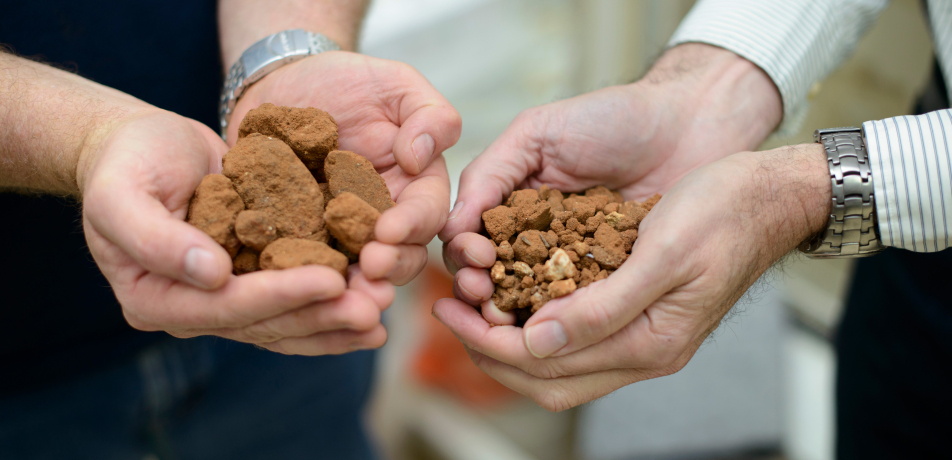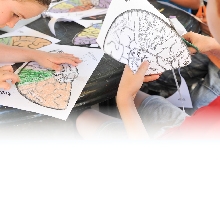Moving earth and sea
Weizmann scientist—and father—Prof. Brian Berkowitz causes tectonic shift in urology by applying his expertise in Earth sciences to save his son’s kidney
Features

Yotam Berkowitz was a strong, healthy 20-something, finished with his compulsory service in the Israel Defense Forces, physics degree in hand and with plans to pursue an entrepreneurial career, when he suddenly began to suffer from kidney stones.
Approximately 10% of the global population will experience at least one bout of kidney stones in their lifetime, although Yotam was relatively young when he went through this painful condition. Difficulties in passing stones can often lead to obstructions within the ureter, which connects the kidney to the bladder. In most cases, breaking up and removing the stone can allow the patient to return to normal life. However, in some cases—as in Yotam’s—a stone fragment passing through the ureter can lead to damage and scarring of the ureter wall, causing a partial or full closure (“stenosis”) of a section of the ureter; this stenosis can ultimately lead to kidney failure if not somehow repaired.
Despite multiple rounds of invasive treatments to address the stenosis, the outlook seemed bleak for Yotam—his ureter would not stay open on its own, reconstructive surgery was not feasible because of the nature of the stenosis, and Yotam’s physician informed him that the likely treatment would be to remove the damaged ureter and—as a necessary but unfortunate consequence—his otherwise healthy kidney. [Note: This was in 2018. Since then, new, effective robotic and grafting techniques have been developed to treat such difficult cases.] Horrified, Yotam’s mother, Melanie, called his father, Prof. Brian Berkowitz, from Weizmann’s Department of Earth and Planetary Sciences, who at the time was attending a conference in Boston on hydrology.
“As a parent, you’ll do anything for your child,” says Prof. Berkowitz, who abandoned the conference to scour literature on the fluid dynamics of urine and alternative treatments for stenosis. He soon identified a potential avenue to repair the stenosis, a process still in the experimental stage, and began studying it in detail. Remarkably, the treatment was being developed by an Israeli company. Melanie began making enquires while Brian was still in Boston, and things progressed quickly from there.
A father’s promise
Originally from Edmonton, Canada, Prof. Berkowitz has been at the Weizmann Institute since 1993, where he and his team conduct experimental analyses and computer modeling of fluid and chemical transport in geological formations—porous and fractured media—primarily in groundwater systems, but more recently in surface water and soil systems as well. From there, they develop new models that realistically describe pollutant migration patterns—including “emerging contaminants” like pharmaceuticals and engineered nanomaterials—and demonstrate the conditions under which soil and groundwater contamination can occur. The Berkowitz team is also developing a series of experimental methods for environmentally friendly chemical treatment of contaminated water and industrial effluents.
As Prof. Berkowitz turned his attention to search for solutions to help his son, he realized that his expertise in fluid dynamics, chemical transport, and biogeochemistry was, in fact, highly relevant. “Human tissue is just another type of porous medium,” he says.
This expertise enabled Prof. Berkowitz to rapidly grasp the process of urine flow and biochemical mineralization on stents—small tubes implanted by physicians to hold open passages in the body of a patient. To maintain urine flow from kidney to bladder, physicians insert various kinds of ureteral stents, for periods of days to months. Aside from causing considerable discomfort to the patient, these stents suffer from two major drawbacks: (1) obstruction/mineralization often appears along the length of the stent, blocking urine flow or causing other damage; and (2) when tumors are present and exert pressure on the ureter, ureteral stents fail as often as 50% of the time within one to four months of insertion. Prof. Berkowitz shudders as he recalls watching his son writhing in pain—from inflammation-inducing stents that were repeatedly inserted to maintain kidney function during months of treatments.
“I made my son two promises,” he says. “First, that he wouldn’t lose his kidney, and second, that I’d find a way to make ureteral stents more comfortable.”
How does a Weizmann expert in hydrology keep such a promise? By voracious reading of the literature, meeting with physicians, attending conferences, and questioning clinical dogma, of course. Stent design has changed little since stents were first introduced in the 1960s, with only modest material upgrades in the late 1970s and improved engineered materials—but not design—over the last two decades. Clinicians had long assumed, based on theories of fluid dynamics, that stents could only work properly at certain restricted diameters. But as Prof. Berkowitz came to realize, much of that assumption was based on an incomplete understanding of actual patterns of urine flow in the urinary tract.
Clinical collaboration
To examine these patterns, he found a collaborative partner in Dr. Yaniv Shilo, Director of Endourology at Kaplan Medical Center in Rehovot. Prof. Berkowitz subsequently captured the interest of environmental chemist Dr. Ishai Dror, a senior staff scientist in his lab. They were soon joined by some of the lab’s graduate students, as well as other Weizmann colleagues, all of whom have been involved in different aspects of a burgeoning research program into biomedical fluid dynamics.
Together, Prof. Berkowitz and Dr. Shilo initiated the development of a one-of-a-kind laboratory system that realistically simulates urine flow from the kidney, through the ureter, and into the bladder. Their experimental apparatus allows for the introduction of ureteral stents of varying diameters, as well as control of the inflow volumetric flow rate and (artificial/simulated) urine chemistry, of the ureter/stent shape, and of the pressure exerted by tumors.
The Berkowitz group soon demonstrated that, contrary to popular clinical belief, pressure alone does not account for the high frequency of stent failure. Rather, the researchers demonstrated that the presence of colloidal material in urine (a common occurrence) is also a critical factor leading to stent failure. In parallel, the Berkowitz group provided key insights regarding the ideal stent diameter and design, which will lead to improved clinical practice and patient comfort—early-stage findings that are already influencing medical management at Kaplan and elsewhere.
In addition to this initial research, Prof. Berkowitz continued in close collaboration with Dr. Shilo to study the early-stage treatment for stenosis—a specialized expandable stent—and to obtain approvals for Yotam to receive the experimental device. The remarkable stent worked for nearly a year and a half before it needed to be removed. Although a long and nontrivial procedure, Dr. Shilo removed the stent successfully, and in near-miraculous fashion, Yotam’s ureter has remained open by itself. His medical file is considered successful and “closed.”
After three years of pain and suffering, Yotam has finally returned to normal life, with both of his kidneys intact—achieving awards and honors with his IDF unit—and Prof. Berkowitz is happy to say that he is finally able to sleep again at night.
“I’m proud and blessed to be part of the story,” says Yotam, “and the catalyst for my father’s research, which will help hundreds of thousands of other people, each year, who are suffering what I suffered.”
Yotam’s outcome is indeed outstanding—not everyone is as fortunate to walk away from stenosis, kidney stones, and the need for further stents—fueling Prof. Berkowitz’s drive to fulfill the second half of his promise to build a better ureteral stent.
An outsider’s perspective
In addition to his “regular” research on hydrology, Prof. Berkowitz is continuing his work to better understand the physical interaction between ureter and stent walls, the dynamics of “debris” transport in urine, and the subsequent implications of mineralization on and within stents. He is also advancing an intensive study of kidney stone structure, formation, and treatment, as well as developing plans for future diagnostic testing via novel forms of urine analysis. His group’s output—an extraordinary 13 peer-reviewed publications in the past few years and counting—is causing a paradigm shift in the field of endourology, as their findings challenge and disprove long-held beliefs about the treatment of kidney stones, why stents cause pain and discomfort, and overall stent design.
For example, the best-practice approach of emergency room physicians dealing with an acute case of kidney stones—in which the patient is at immediate risk of death due to kidney infection—is to insert the largest stent possible into the ureter to drain the kidney. Using a specially designed in vitro model constructed by staff scientist Dr. Vyacheslav Kalchenko in the Weizmann Institute’s Department of Veterinary Resources, the Berkowitz group was able to demonstrate that all stent diameters drain kidneys with the same efficacy—thus disproving the common perception that larger diameter tubes are more effective. The article appeared in the June 2022 issue of the World Journal of Urology. Moreover, the paper was presented at the annual conference of the Israel Association of Urology, where it was recognized with an award for outstanding research in endourology.
Another study addressed the critical lack of research on stent use and management. The Berkowitz group used micro-computed tomography (micro-CT) to image external and internal stent mineral encrustation in different ureteral stents. The group demonstrated that significant encrustation could occur anywhere within a stent, even when there is minimal encrustation on the exterior. This finding has important implications for long-term stent use and appeared in the April 2022 issue of Research and Reports in Urology.
A related study on the relative volume of fluid flowing through the ureter versus through stents included yet another unusual collaboration for Weizmann earth scientists—this time with staff scientist Dr. Talia Harris, an expert in magnetic resonance imaging (MRI) from the Department of Chemical Research Support.
One of the most significant paradigm-shifting studies concerned a major cause of stent discomfort: the anchor curls that hold the tube in place within the body. Although effective, the anchor curls can irritate and inflame the ureter as well as the bladder. In 2022, Prof. Berkowitz and Dr. Shilo, working with Dr. Udi Willenz of the Shamir Medical Center in Be’er Yaakov (formerly Assaf Harofeh), presented a proof-of-concept evaluation of an innovative new stent with modified anchors that rest entirely within the ureter—and nevertheless stay put. Dubbed the “YotiCurl” (in honor of Yotam), the novel stent proved safe and effective in an animal model. Work is ongoing to demonstrate its effectiveness in additional model systems, with the potential to offer patients a vast improvement to their quality of life. The findings were published in June 2022 in Translational Andrology and Urology.
With assistance from Yeda Research & Development, the Weizmann Institute’s tech transfer company, Prof. Berkowitz and Dr. Shilo have submitted a patent application for the YotiCurl, as well as for two other endourology-related products.
A geologist walks into a urology conference
Prof. Berkowitz enjoys the looks of surprise when he attends urology conferences and people see his departmental affiliation. He appreciates that with their intense, busy schedules, clinicians have limited time to comb the literature or conduct research. Sometimes it takes an outsider, although he says he could not have done it without his partnership with the unusually receptive Dr. Shilo.
The pair have become close friends, engaging in lively debates as they work to find optimal solutions for patients, often into the wee hours of the night. Says Dr. Shilo, “Throughout my career, I have met many scientists and medical researchers, but I have never met someone as curious, enthusiastic about science, diligent, and eager to succeed as Brian.”
Adds Prof. Berkowitz, “Yaniv looks at it from the clinical side, I look at it from the physical/chemical side. It’s a beautiful relationship.”
And it is one that not only saved Yotam’s kidney but may also one day do the same for patients around the world.
Brian Berkowitz is supported by:
- Mary and Tom Beck-Canadian Center for Alternative Energy Research
- Sam Zuckerberg Professorial Chair in Hydrology







